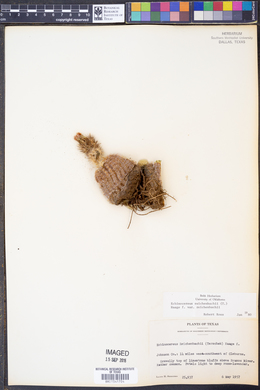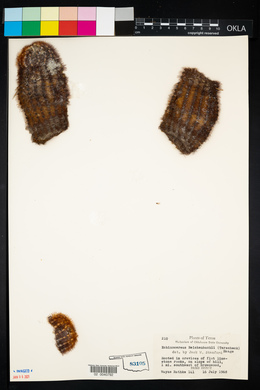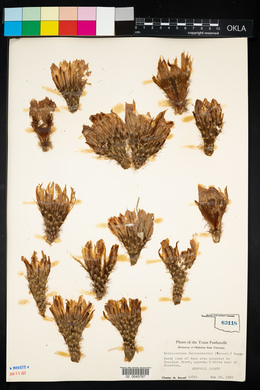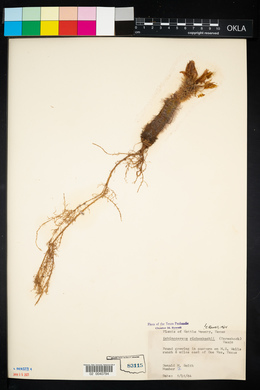|
|
|
|
Family: Cactaceae
|
Plants unbranched or sometimes 12-branched. Stems erect, cylindric or short cylindric, 7.5-30(-40) × (2.5-)4-10 cm; ribs 10-19, slightly undulate; areoles 1-6(-10) mm apart. Spines 15-36 per areole, white to tan, dull pink, dark brown, or purplish black, central spines and spine tips often darker; radial spines 12-36 per areole, straight to slightly curved, appressed, pectinately arranged or nearly so, 2-8(-25) mm; central spines 0-7 per areole, terete, 1-6(-15) mm. Flowers 4.5-8(-12) × 5-10(-12) cm; flower tube 22-40 × 10-30 mm; flower tube hairs 5-15 mm; inner tepals silvery pink to magenta, usually white, crimson, green, or multicolored proximally, 23-40 × 5-15 mm, tips relatively thin, delicate; anthers yellow; nectar chamber 2-5 mm. Fruits green, olive green, or dark green, 15-28 mm, pulp white. 2n = 22. Flowering early May-late Jun; fruiting 1.5-2.5 months after flowering. Chihuahuan Desert, desert scrub, grasslands, oak-juniper woodlands; of conservation concern; 0-1500 m; Colo., Kans., N.Mex., Okla., Tex.; Mexico (Coahuila, Nuevo León, Tamaulipas). The entire Echinocereus reichenbachii species group (E. reichenbachii, E. chisosensis, E. rigidissimus, E. pseudopectinatus, and an indefinite number of Mexican species) has unusually thin, bristlelike spines clothing the flowers and fruits as well as conspicuous, cobwebby tomentum of unusually long areolar hairs. The persistent, dry, white features of the flower tube are an essential distinction contrasting with the otherwise similar E. pectinatus species group (E. pectinatus, E. dasyacanthus, and possibly E. bonkerae), regardless of the spectacular, colorful floral displays. The taxonomic and geographic boundaries among the segregate species or numerous proposed infraspecific taxa of Echinocereus reichenbachii remain nebulous and controversial. In no place do pure populations exist sympatrically, and all taxa appear completely interfertile. Typical E. reichenbachii is endemic to Mexico, near Saltillo, Coahuila. The common plants of E. reichenbachii in Texas, usually lacking central spines, are weakly distinguished from typical E. reichenbachii and are the basis for E. reichenbachii subsp. caespitosus. Oklahoma populations with unusually long bristlelike spines were named E. baileyi Rose [E. reichenbachii subsp. baileyi]. They intergrade, however, with the nearby, short-spined populations of E. reichenbachii. Echinocereus reichenbachii var. albispinus pertains to intermediates between E. baileyi and E. reichenbachii subsp. caespitosus. The flowers of E. reichenbachii var. fitchii are among the largest in the species, and their exact color pattern may prove taxonomically significant. Echinocereus reichenbachii var. albertii is somewhat morphologically and geographically intermediate between var. caespitosus and var. fitchii, but with flowers more closely resembling var. fitchii; it is sometimes considered a synonym of var. fitchii or a variety of E. fitchii Britton & Rose. The name 'Echinocereus melanocentrus' appears frequently in cactus literature but has not been validly published. Echinocereus reichenbachii is in the Center for Plant Conservation´s Collection of Endangered Plants.
|

















































